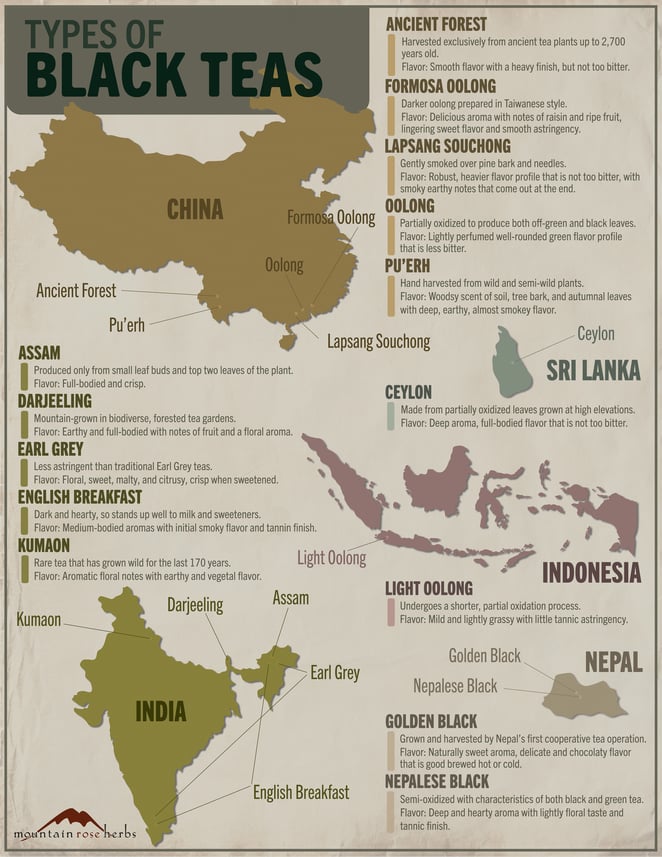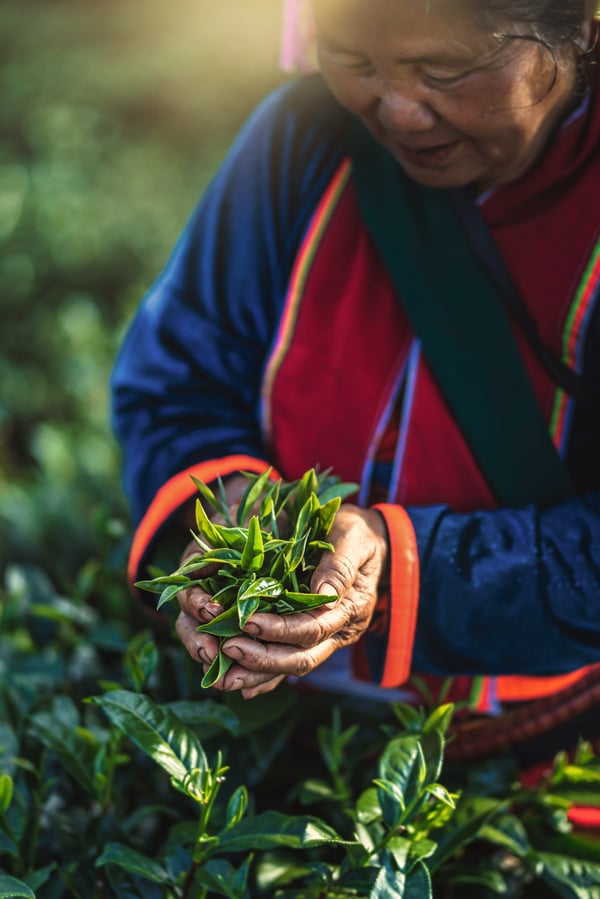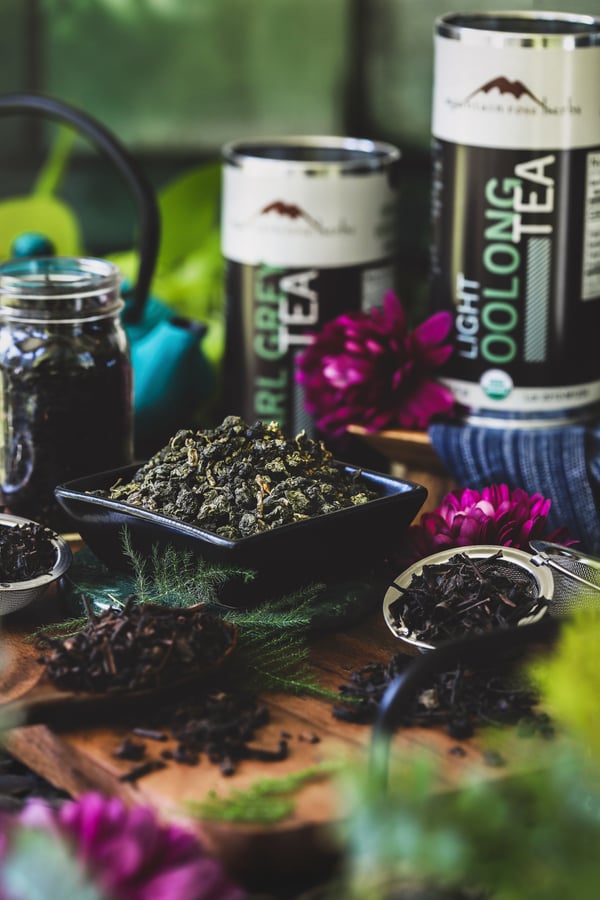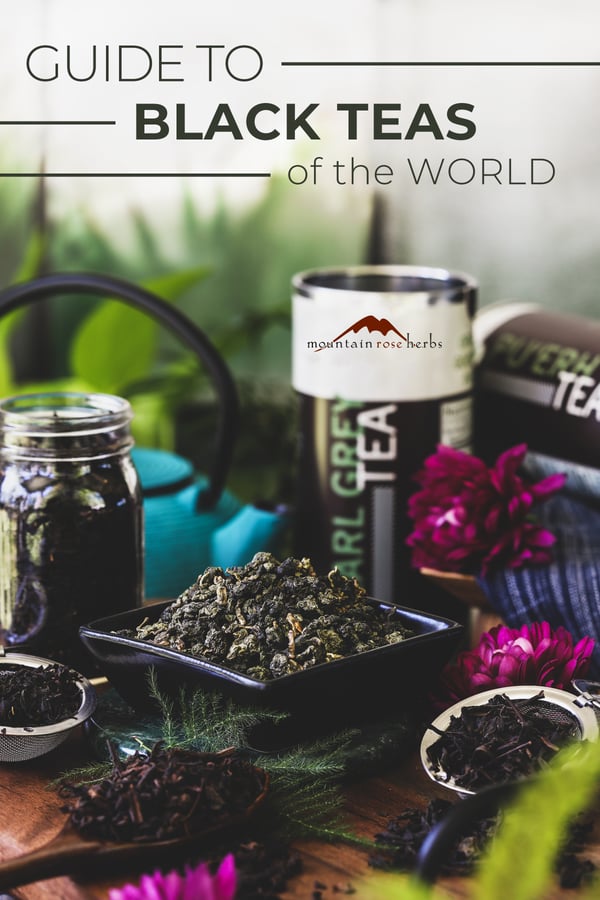Camellia sinensis is one of a small number of botanicals on the planet that has altered the course of history. This single precious plant—from which black, green, and white teas, among others, are made—has, for better or worse, been responsible for both the making and the fall of empires. Although it is the mother plant of a variety of teas, its power in the global marketplace is particularly potent when its leaves are fully oxidized to make black teas. Black tea is the most popular type of tea in the world, including here in the States. In 2019, the Tea Association of the U.S.A. reported that people in the U.S. consumed over 3.8 billion gallons of Camellia sinensis-based teas, 84% of which was black tea. What is it about black tea that is so alluring?
China was documenting medicinal tea use as early as 1,000 BCE. It remained primarily a medicine for hundreds of years and wasn’t recorded as a beverage drunk simply for pleasure until the Tang Dynasty (601-907 AD). The methods that Chinese tea farmers used to grow and dry tea leaves were closely guarded secrets and, for a long time, the government only allowed dried leaves to be exported so that China was the sole source of tea for the ever-growing global market. In fact, Carl Linnaeus, the father of modern taxonomy, was not able to get live specimens to study and reference and, thus, originally and incorrectly determined that black and green tea must come from different plants. This was resolved in 1842, when English ethnobotanist Robert Fortune smuggled live tea plants out of China, at which point botanists discovered that it is not a different plant that makes black and green teas (as well as oolong and white teas), but a different method of processing the leaves.
Why Do Black Teas Taste So Different?
Tea varieties and flavor are affected by the specific variety of Camellia sinensis bush that the leaves are harvested from, as well as the terroir in which they grow and the ways they are harvested. When left to their own devices, the various varieties of the “tea plant” grow to become a large evergreen shrub or small tree, but on tea plantations, they are kept pruned to a reasonable height for ease of harvesting. Tea pickers must be able to reach the topmost growth, where the leaves and buds are still tender because as the leaves grow larger, they get too tough and waxy for tea production.
The key component, however, in what makes your favorite black tea taste that particular way that you love is what happens to the leaves after they are harvested. Every tea made from Camellia sinensis is the result of a series of tea processing steps that include if and how the leaves are withered, heated, rolled, oxidized, and dried. Generally, black teas go through four of these steps.
It takes a lot of leaves to make one pound of tea: as much as 6,000 individually plucked leaves per pound! Those thousands of leaves must first be dried, a process called withering. The freshly harvested tea leaves are spread out in an even layer and left to wilt. Traditionally, this was done outdoors in the sun and breeze. Modern tea makers now most often wither the leaves inside using technology to carefully control air circulation and humidity in order to achieve the perfect amount of moisture loss and create the best flavor. This initial process of decreasing the water content takes up to 14 hours to complete, using fans to speed up the process if necessary and shade cloths to slow it down if the leaves are drying too fast. Different tea varieties require different drying times and conditions.
For green teas, the leaves are now heated so that no oxidation will occur and they will retain their green color. For black teas, however, it is important to start the oxidation process quickly because this is what creates black tea’s unique color and flavor. To initiate oxidation, the cell wall of the tea leaves must be broken. This is done through a rolling, massaging process that releases an enzyme called oxidase, as well as the essential oils in the leaves, and exposes them to oxygen, creating a chemical reaction that turns the leaves brown or black and which enhances the sought-after black tea flavor. This step was traditionally hand-done but is now better managed using specialized machinery.
The leaves are then set aside to rest and oxidize. Over the next several hours, the tea leaves change from green to brown. When they are perfectly oxidized, they are put in a dryer—usually at 175-195° F—to stop the oxidation process at the right point, lock in the aromatic oil compounds, and prevent microbial growth.
Voilà—except for cutting and a final sifting—your black tea is finished!
There are a variety of points in the process—from the moment the leaves are harvested, all the way through the drying stage—in which slight variations can make big changes in the flavor profile. For instance, pu’erh is a special black tea variety that undergoes an additional step in which the leaves are fermented. After they are dried, they are heaped up to “cook” and then are specially stored to give them time to age and ferment, a process that adds a new level of depth and complexity to the flavor profile. Depending on the variations in harvesting and processing, black teas may range from a reddish color to deeply brown when brewed, and will also have a range of flavors; they may taste roasted, tannic, smooth, or biting. Also, variations throughout the process can change caffeine content. Black tea is usually thought of as having more caffeine than other Camellia sinensis tea varieties, but this isn’t always the case.
- Shade-grown teas (such as matcha) are almost always higher in caffeine than sun-grown teas.
- The top leaves of tea plants generally have higher quantities of caffeine than the lower leaves.
- Tea leaves cut into smaller pieces release caffeine more quickly in hot water than whole-leaf varieties.
- Using water that has reached a full 212° F (boiling point) will result in more caffeine than a cup brewed with lower-temperature water.
Mountain Rose Herbs offers an extensive collection of the finest-quality organic black teas that are rich in flavor. Below is a list with a little description to help you understand why you love a particular variety and also to make it easy for you to explore new teas that might be a welcome addition to your own collection.

Text Version of Infographic:
- Ancient Forest Tea- Yunnan Province, China
- Distinctions: Harvested exclusively from ancient tea plants up to 2,700 years old.
- Flavor: Smooth flavor with a heavy finish, but not too bitter.
- Assam- Assam region, India
- Distinctions: Produced only from small leaf buds and top two leaves at the tip of the plant.
- Flavor- Full-bodied and crisp.
- Ceylon- Sri Lanka
- Distinctions: Made from partially oxidized leaves grown at high elevations.
- Flavor: Deep aroma and full-bodied flavor that is not too bitter.
- Darjeeling- India
- Distinctions- Mountain-grown in biodiverse, forested tea gardens
- Flavor: Earthy and full-bodied with notes of fruit and a floral aroma.
- Earl Grey- India
- Distinctions: Mountain Rose Herbs’ Earl Grey is generally less astringent than most Earl Grey teas.
- Flavor: Floral, sweet, malty, and citrusy, crisp when sweetened.
- English Breakfast-India
- Distinctions: ark and hearty, so stands up well to milk and sweeteners
- Flavor: Medium-bodied aromas with initial smoky flavor and tannin finish.
- Formosa Oolong- China
- Distinctions: Darker oolong prepared in Taiwanese style
- Flavor: Delicious aroma with notes of raisin and ripe fruit, lingering sweet flavor and smooth astringency.
- Golden Black- Nepal
- Distinctions: Grown and harvested by Nepal’s first cooperative tea operation
- Flavor: Naturally sweet aroma, delicate and chocolaty flavor that is good brewed hot or cold.
- Kumaon- India
- Distinctions: Rare tea that has grown wild for the last 170 years
- Flavor: Aromatic floral notes with earthy and vegetal flavor.
- Lapsang Souchong- China
- Distinctions: Gently smoked over pine bark and needles
- Flavor: Robust, heavier flavor profile that is not too bitter, with smoky earthy notes that come out at the end.
- Oolong- China
- Distinctions: Partially oxidized to produce both off-green and black leaves
- Flavor: Lightly perfumed well- rounded green flavor profile that is less bitter.
- Light Oolong-Indonesia
- Distinctions: Undergoes a shorter, partial oxidation process
- Flavor: Mild and lightly grassy with little tannic astringency.
- Nepalese Black- Nepal
- Distinctions: Semi-oxidized with characteristics of both black and green tea
- Flavor: Deep and hearty aroma with lightly floral taste and tannic finish.
- Pu’erh- China
- Distinctions: Hand harvested from wild and semi-wild plants
- Flavor: Woodsy scent of soil, tree bark, and autumnal leaves with deep, earthy, almost smokey flavor.
Other Specialty Black Teas Offered By Mountain Rose Herbs
- Classic Chai
- Mango Ceylon Tea
- Orange Cream Oolong Tea
- Orange Spice Black Tea
- Study Time Tea
- Vanilla Black Tea
WANT MORE INFORMATION ABOUT HOW TO BREW THE PERFECT CUP OF TEA?
Check Out This Guide to Brewing Tea
You may also enjoy:
- What Is the Difference Between Black, Green, and White Teas
- Guide to Green Tea: How to Determine Quality and Flavor Expectations
- Yaupon: Rediscovering America’s Forgotten Tea













